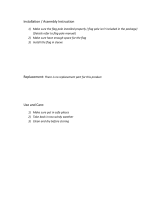
4 B U R L E Y T R A I L E R O W N E R ’ S I N S T R U C T I O N A N D S A F E T Y M A N U A L
B U R L E Y T R A I L E R O W N E R ’ S I N S T R U C T I O N A N D S A F E T Y M A N U A L 5
Starting and Stopping
Because of the trailer’s additional weight, a bicycle pulling a trailer will be
slower to start and stop, and because of its length, requires more time to
cross streets or paths. Your entire vehicle is heavier and less responsive.
Think ahead and anticipate stops, turns and starts. Note that your trailer ex-
tends further out on the left; allow for this difference when turning, passing
pedestrians or approaching obstacles, such as posts on bike paths. Experi-
ment with a loaded trailer in an uncongested area to become familiar with
how your heavier, longer vehicle responds.
Prevent Trailer Tip Over
Like automobile and motorcycle trailers, bicycle trailers can tip over. Do not
pull your trailer over curbs or hit holes or other road obstructions. Instruct
children not to bounce or lean, which can cause a shift of weight. Do not
make high-speed turns or descents when pulling the trailer. Always corner
with caution at 5 mph or less, as the trailer cannot lean into a turn the way
a bicycle can. Do not travel faster than 15 mph—all road irregularities and
your slower reaction time are greatly magnified.
Trailers can tip over, causing damage to trailer and serious injury to
cyclist or passengers. AVOID causes of tip over, especially:
WARNING
• Children leaning or bouncing
• Hitting potholes, curbs, other
road obstructions
• Taking turns too fast
• Sudden swerving
• Off-banked turns
• Improper wheel installation
• Improper tire inflation
No Motorized Vehicles
Never pull your Burley trailer with a motorized vehicle, as the increased ac-
celeration and speed could damage the trailer or cause it to tip over.
Always Use Your Cover
To protect your children from flying debris, always use your cover. Never leave
children unattended in direct sunlight, as heat buildup in the trailer can
cause serious harm. Open or close the vinyl window and periodically check
to make sure your children are comfortable.
Wear Helmets
Numerous studies have shown that head injury is the leading cause of bi-
cycling fatalities. Helmets prevent or reduce bicyclists’ head injuries; it is
essential that both cyclist and passengers use approved bicycling helmets
at all times.
Proper Wheels and Tires are Essential
Use only the factory-supplied wheels, and keep them properly maintained.
Inflate tires to 30–35 P.S.I. and check pressure before each use. Do not use
higher-pressure tires or knobbies. We recommend using only tires with street
tread.
Know Your Trailer Hitch
Clamp the hitch securely to the bicycle frame, and check for a tight attach-
ment each time you use the trailer. Refer to “Hitching Your Burley to Your
Bicycle” and “Maintenance and Storage” sections of this manual for proper
installation, use and maintenance of your hitch.
Use Your Flag
Always use the safety flag—it will help make you more visible to motorists and
other cyclists.
Protect Your Children
Use the shoulder harness, lap belt, and child helmets on your children at
all times. Always fasten the seat belt so that each child is held securely. For
maximum stability and safety, seat a single child in the center of the trailer.
Periodically check placement of the shoulder straps, especially for sleeping
children. Make sure children cannot put a finger into the wheel spokes.
Observe Age and Height Restrictions
The trailer seat is intended only for children old enough to wear a helmet
and sit upright and alone. Adequate neck strength is required to hold his/her
head upright while trailering. A physician should evaluate anyone who is of
questionable developmental age for trailering. Never carry a child whose sit-
ting height (with helmet) is above the roll bar, because their chance of injury
is significantly higher in the event of a tip over.




















